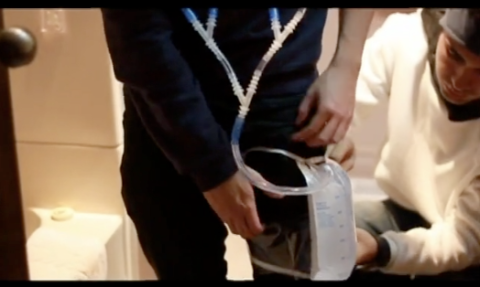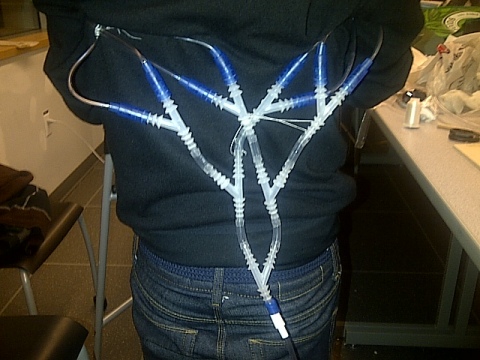The Making of Miasma continued
December 8, 2010 § Leave a comment
December 7th, Tuesday 2010
After weeks of trial and error, since sketch two, this was our main issue and obstacle to overcome. Today we successfully got the motor to turn in one way to add pressure and squeeze the water up through the veins, and turn in the other way to release pressure and cause the water to flow back down. We rebuilt parts of our motor by creating a wooden dowel on the aluminium end to in order to stabilize the rotation. We also chose to shifted water bag up and place the motor component on top of bag for more convenience. This week we are focusing on building wooden compartment to store the water and motor parts to make it more aesthetically pleasing.
For the veins, we took Greg and Jinsil’s advice to lengthen them by adding heat shrink tubing for the structure, which proved to be very helpful. We also got additional advice from Greg and Jinsil to move the bulk of system of veins to the back. By rerouting the flow of water in the veins, it will be more functional, since the back will not cause the veins to bed inward in comparison to placing them on the chest.
We considered different fabric and materials by taking samples from Fabricana. We narrowed them down and deciding on experimenting with Velcro, to strap on the water bag and motor component to the body, and faux leather to integrate into the aesthetics of our design. For the neck piece we decided we were going to redesign it and instead of the clear vinyl and clear thread, we are considering just keeping the veins as they are with a little bit of fabric for a cleaner and a more structured look.
Shocking/Pain factor still needs to be developed and we are still waiting for the
WiFi detector to be delivered from Hong Kong. Further more, the Arduino code still needs to be finished.
The Making of Miasma
December 8, 2010 § Leave a comment
The Making of MIASMA
November 30th, Tuesday 2010
This week we are focusing on securing the form of the motor component of our prototype in terms of placement and stability. Refining and constructing the individual parts and making them work as a whole is the main focal point.
We wanted to further develop our conceptual aspect by adding a pain factor in our project so the user can physically feel the shock value of how the WiFi connection negatively affect their physical state. To expand from our pain concept, technical development including further research will be developed as to how to induce electrical shock and integrating it to our form. As a starting point, we bought a lighter from a dollar store and took it apart to examine the components of the pieces that created a spark. (insert video clip here, or in the end we can compile our entire process into one video). From testing different electric shock components to figuring out the mounting system for the electric shock components are to be explored to find an effective way to create our pain component for the project.
Aesthetically, we are currently experimenting with the different kinds of materials and forms so that it will be visually appealing, yet satisfies the functionality of our design. For instance, the finalization of the pattern and shape of the veins and putting together into a wearable plastic
neck-piece.
Felt template for the neckpiece

Clear Vinyl version of the neckpiece (The structure and cutout pieces of clear vinyl and thread looks better in real life)

Final Reading Assignment
December 6, 2010 § Leave a comment
Final Reading Assignment:
Constituting, Traversing and Perforating Boundaries: Embodied Interaction in Immersive Virtual Spaces
Summary:
This paper is based on the boundary of a transformative extension of the human’s body between participants and virtual environments. Interactive immersive virtual spaces increase a participant’s range of actions to a limited set of reactions. Interaction installations depend on the participants’ “presence and communication” in order for an immersive relationship to occur between humans and systems.Virtual reality creates a sensory involvement with participants where the boundaries between a person’s inner self and body are continuously negotiated. These virtual environments allow the body to be a passive receptor and establish interplay between the “participant’s embodied self and its computated representation and transformation.” The user’s virtual environment becomes “an extension of their bodies” where they further their being in another space, but this depends on the level of interactivity. For instance, the virtual environment Uzume, evolves based on the participant’s movements. Depending on the motion of the user and their range of actions, the virtual environment responds accordingly, based on the user’s level of dynamic notions.
Quote:
Rather than creating finished works, the interactive artist creates relationships.
Summary Phrase:
Interactivity and participation between human and system depends strongly on action and reaction.
Final Project Update
December 6, 2010 § Leave a comment
Yesterday I worked on sewing wearable neckpiece component of our prototype together. Andrew made a template out of a felt material, which I used as a guide to sew the vinyl. Since the material that we had was not working in my favour, I went to the fabric store to search for another kind of vinyl as well as clear thread. The material I ended up purchasing was easier to mold and fit onto the body compared to our previous materials. Tomorrow I am going to sew the last part of the neckpiece by securing the buttons. Tomorrow I will post a picture of the updated neckpiece.
Final Project Process
December 1, 2010 § Leave a comment
On Monday I had the privilege to join a new group to work with on the final project which I am excited to get started. Since the team is expanding from their Sketch 2, there was a lot of catching up to do in terms of their process and how their project is structured. However, after I got a chance to read through all of their blogs and talk to them during lab, I felt it was really helpful for me to understand in detail of their teams’ goal. I felt very encouraged and welcomed as they included me in their team.
Description of our project:
Miasma is a wearable critical design artifact that explores the interaction between humans and wireless networks. It intends to raise the question: What if wireless networks serve as a detriment, rather than a benefit to a society and people in the near future.
Overview thus far: Sketch 2 slides
Aesthetics
Process of the wearable component

Functionality
Process of body sketch



Team member’s blogs
Ben
Andrew
Vando


